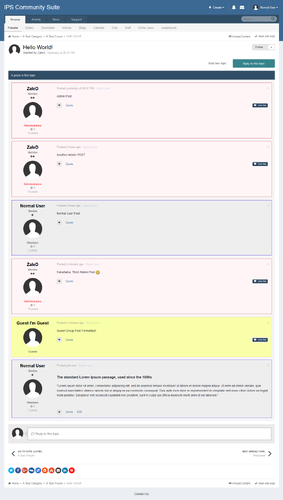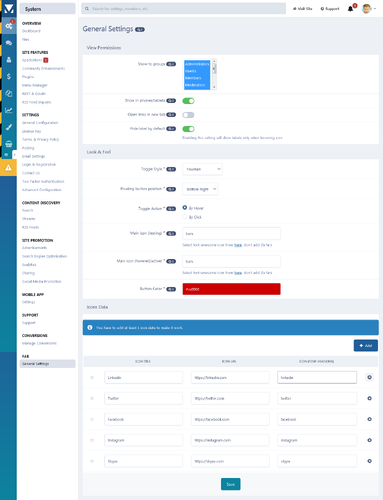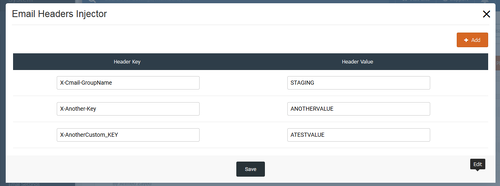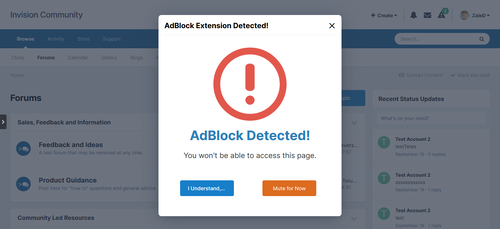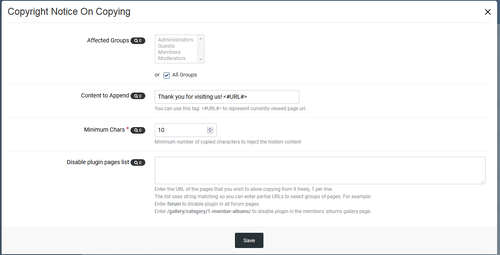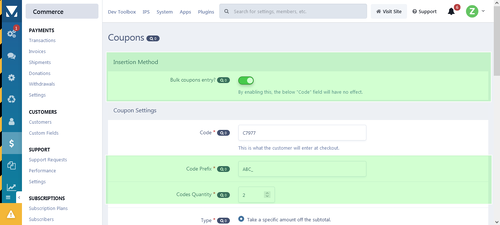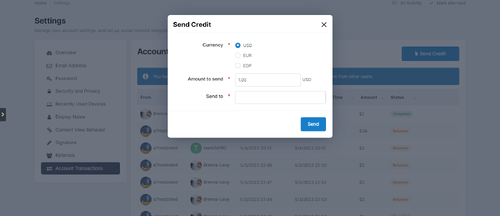
A Zayed
Administrators-
Posts
105 -
Joined
-
Days Won
10
Content Type
Profiles
Store
Gallery
Forums
Marketplace
Everything posted by A Zayed
-
Version 1.0.0
0 downloads
"I'm Calling You" is a simple plugin to increase engagement between your community and your members... By using a word tag, for example, [you]... you can talk directly to the logged-in user inside posts. For example, if a user types this line in the editor: It'll be converted automatically to this:10.00 USD -
-
Version 1.0.1
2 downloads
This app will add a fixed floating action button to the desired area in the page with multiple actions that will appear on hover/click. App features: Group permissions. Enable/disable button on mobile/tablet view. 4 Toggle styles (Slide-in, slide-in spring, zoom-in, fountain). 4 Button positions (Bottom right, bottom left, top right, bottom left). 2 Toggle actions (Click, hover). Buttons colour and main icon style (Font-awesome). Setting to control URL click behaviour (Open URL in a new tab or on the same page). Setting to hide/show URL title by default. You can add up to 10 child icons (You can set the icon, URL and title to whatever you want). Demo video (4 toggle styles in action):20.00 USD -
Version 1.0.1
3 downloads
This plugin uses validator.pizza API to validate users' email addresses during registration and during personal email changes. The plugin checks if the email is: Disposable (10-minute emails... etc.) Alias I'm up for any recommendations or suggestions to improve plugin action.15.00 USD -
-
Version 2.1.10
6 downloads
With this app you will be able to detect AdBlock & AdBlock+ browser plugin that blocks your website ads. It will display a block message that will disable all website if the user didn't disable his AdBlocker.... This application comes with these features and options: Select user groups that will be blocked if they enabled AdBlocker. Allow user to dismiss the message or not. Option to remember user selection (To be less aggressive), and this option is retested once admin edit plugin options. Choose if you need to disable the vertical navigation scroll bar. Enable/Disable the black overlay background (Totally hide the content). Adjust blocking message size (Small/Medium/Full Screen) Message Header Text. Message Body Text (Full CKE). Customized Buttons Texts. Support for different adBlockers (AdBlock Plus, AdGuard, uBlock, Ghostery....). This application is tested by many customers and assured to improve your ads income. I'm up for any suggestions and recommendations, feel free to PM or email me directly. *** Important Before Purchasing *** Although I'm trying to release updates to bypass adblockers and avoid application detection, I can't guarantee 100% that the application can bypass all adblockers. Before purchasing, make sure your website is not listed in uBlock filters lists from here: If your website is listed in any of these filters, I can support to bypass it (For Extra Fees).15.00 USD -
Version 1.0.2
3 downloads
This application will show available payment methods in main product page before user decides to checkout. This is useful to improve user experience, by saving user time to have the knowledge about available method before creating an invoice. The application has the following features: A Per method icon, you can upload image for every payment method. Setting to show icon only, title only or show both of them in the same time. Setting to change separator color. Setting to change separator thickness. Setting to control icon image width.20.00 USD -
Welcome to Invision Community 5! Over the coming weeks, we'll be exploring a bunch of new features and improvements coming to our user interface including our brand new theme editor, a new mobile UI, dark mode and performance improvements thanks to a reduction in both JavaScript and CSS. To kick off this series, let’s take a closer look at the new sidebar layout and new view modes for the forum index and topic pages. Sidebar Layout Traditionally, Invision Community has shipped with a horizontal header and navigation bar at the top of the page, which is still available in version 5. We're introducing a brand new (and optional) sidebar layout, which can be enabled or disabled easily from within your theme settings. The sidebar not only provides convenient access to your applications, activity streams and search bar, but you can now add links to nodes for even easier access to popular or commonly used areas of your community. For example - a category from your forum, an album from the Gallery, or a product group from Commerce. Sidebar-zoom.mp4 Forum Index: Feed view One of our goals for version 5 was to re-imagine new ways for your visitors to consume content, and the sidebar layout is just one of our solutions. Table view has been the typical way of displaying forums, providing visitors with a simple summary of the most recently active topic. Grid mode introduced cover photos to forums and is a great way to make your page more visually engaging, while fluid view allows visitors to filter through a list of topics to easily focus on multiple areas of the community. Joining these view modes in version 5 is our new Feed view. Optional cover photos and featured forum colours allow you to personalise each forum, and a list of recently active topics with snippets of the most recent reply allow you to easily see what each forum is focusing on at a glance. The topic list drops below the cover photo and converts to a scrollable list on small devices. It's our fresh take on content display, and we can’t wait to hear your feedback! Topic pages: Compact view In addition, Invision Community 5 also introduces a new, compact layout option for topics. We wanted to create a layout which placed focus on your content while still keeping all of the authors profile information easily accessible within a mini profile. Stats, rank, badges, reputation points and more can be found by tapping the icon at the top of every post. The mini profile strip has also been added to other areas of the software too, such as comments and reviews in applications like Gallery and Blogs, and will appear on the mobile layout when the traditional "table view" is used in topics. Switching between the new compact view and the author sidebar view takes just seconds giving you complete control over your community. Mini profile.mp4 As part of this view, you also have the choice to feature/pin the original post to the top of every page, making it a breeze for your visitors to easily understand the context of replies without navigating back to page 1. Pinned posts have a slightly larger font-size to distinguish them from replies, and we've thoughtfully truncated them on pages beyond the first to keep scrolling to a minimum. The new sidebar layout and view modes offer a fresh and innovative approach to navigating and interacting with your community. We’re really keen to hear your thoughts on these new views and whether you’ll be unleashing them on your own sites! We appreciate that no two sites are the same, and those who are a fan of the classic header look will benefit from quick styling tools and a visual way to re-arrange the header elements which we’ll cover in a later blog. We’re looking forward to showcasing a whole bunch of new features over the coming weeks - so stay tuned, and we’ll see you then!View the full post
-
Version 1.0.3
0 downloads
This application will give admins/users the power to customize member display name apart from primary user group customization... Original app credits goes to "Shir Raanan", the original plugin developer for earlier 4.x versions. App features: Admin has option to allow users to modify their display name. Admin can set 2 display name color modes (Free mode/Restricted mode). Admin can set list of selected colors in restricted font color mode. Admin can set list of sparkling background for display name. Admin can customize the name directly from ACP with full HTML formatting. App mainly depends on caches to avoid database querying every time. This app. is subject to improve and enhance according to your suggestions and reviews.25.00 USD -
Version 1.0.6
1 download
Simply, This plugin will inject text into any post copied from your site (by "Ctrl+C" or "Right Clicking then Copy")... When I user copies (Ctrl+C) this content: "lorem ipsum dolor sit amet" When the user paste (CTRL+V), the content will be (for example): "lorem ipsum dolor sit amet" Read more here : Some URL This's very useful to get a backlink to your site...20.00 USD -
-
Version 1.0.0
6 downloads
This application will allow your community users to send/receive nexus app account credits between each other. This application requires IP.Commerce app to be installed. Application scenario: User A send credit of $5 to user B. User B is notified by this movement, and asked to confirm. Once User B confirm (Unfreez), the amount is deducted from User A and added to user B. Admin has the authority to refund or cancel the transaction.25.00 USD -
Version 1.4.16
24 downloads
This plugin makes use of the Parser class to make a preview for the posted external URL inside the editor. When an external link is pasted into the editor, it is automatically expanded into a preview of the content, usually with an accompanying image, allowing users to click through to that content if they are interested. Plugin features: Supports a variety of external URL contents (Media, news, communities... etc.) Option for Simple/Rich embeds. Control what content to display (Title, URL, Host, Favicon, Description, Image) Option to exclude URLs from being retrieved. Control which user groups that can use it. Display options: Show/Hide wrapper. Width of wrapper. Image height. Title truncation. Description truncation. IMPORTANT NOTE BY DEVELOPER: This plugin doesn't support Amazon products embed Simple Mode Demo: Rich Mode Demo:25.00 USD- 1 review
-
- 1
-

-
The Marketplace is closing on October 30th 2023. If you haven't already read the announcement, please read it first. As our Marketplace prepares to close its doors, we want to ensure a seamless transition for our customers. To facilitate this process, we're introducing a new 'license key' system to allow you to transfer your purchases to the third-party developer website in a privacy-conscious way. On the 'My Purchases' page, you'll find an improved layout displaying each resource you've purchased from the Marketplace. This includes the original purchase date, the expiry date (if applicable) and the current renewal term (if applicable). Additionally, we've added two new enhancements. First, you'll notice the purchase-specific license key (depicted as XXXX in the screenshot). This license key is accessible to the third party author and can be provided to them through their website or other means. It enables them to confirm your payment for the resource and check its activation status. Secondly, we've added a link to their profile in the Providers Directory (if applicable). You can find contact details and a link to the provider's website on their profile. We hope that these additions will help make the transition as smooth as possible. Third Party Developers Developers can now access the new 'My Sales' area, where you'll find a searchable list of resources that have had sales on the Marketplace. This list may include resources that were previously hidden. Clicking on any of these resources will display a list similar to the old 'my paid files.' Here, you'll find detailed information for each purchase, including purchase and expiry dates. Additionally, the list now includes the customer's current renewal term, which may differ from the initial purchase due to pricing changes. Furthermore, you'll notice the new license key, conveniently searchable in the top right corner. We've also made the list of purchases available in CSV format, allowing for easy integration into your own website or marketplace. Please let us know if you have any questions and we hope these new tools will ease the transition from the Marketplace.View the full post
-
Everyone at Invision Community is pleased to introduce Community Hive. We are creating a new free-to-use service to help independent communities reach new audiences and re-engage existing members. Community Hive delivers updates from your favourite communities and helps you explore new ones by bringing all the communities you follow into a single feed with optional email updates. The Invision Community September 2023 release will bring Community Hive integration to Invision Community and we're also releasing integrations for XenForo, Squarespace and WordPress. More integrations for popular platforms are planned over the coming months. The "Why" We believe in the power of independent communities. Technology has changed over the two decades we've been building community tools and despite the advances in technology a key problem independent communities still have is re-engaging existing members and finding new audiences. Social media has diminishing returns, and search results continually down-rank user-generated content. Reaching new audiences has never been more challenging. Community Hive solves that by providing a single platform to showcase your content to new and existing audiences. We don't keep your content; the only way to engage is to visit your site, ensuring you retain complete control and ownership. Regular updates via email and push notifications reach your existing members wherever they are. As our attention spans shorten and our online time becomes more cluttered, checking in with each community becomes more of a struggle. Independent and forum based communities fight for attention with social media, and owned platforms like Discord and Slack. Allowing your members to follow your community with Community Hive gives you increased visibility and discoverability and helps level the playing field. The Platform Community Hive has a familiar feed view with two main areas. "Following" shows a feed of communities you already follow to ensure you see more of what you like. This feed learns over time what content you favour and ensures you see more of what you like. The "Discover" tab shows you a feed of content from communities outside of your following list, which is a great way to discover new online communities to join. Following is easy; you don't even need to register on the community to add it to your followed list on Community Hive. Robust account management makes it easy to unfollow communities and set your desired audience classification preferences. Community Hive is mobile-first with push notifications and is ready to be added to your phone's home screen as an app. Integration Community Hive will launch with integration for several platforms such as XenForo, Squarespace and WordPress. Invision Community integration has several tools to nudge your members to add your community to Community Hive with buttons in key follow areas. Following from a community only requests your email address. You can optionally set a password later on Community Hive to enable your feed to be viewed on multiple devices. Clicking "Follow on Community Hive" from an Invision Community when you have an account with that community. Clicking "Follow on Community Hive" from an Invision Community when you do not have an account with that community. Community Hive will be launched in beta alongside Invision Community's September 2023 release, with integrations released for other platforms. You can visit Community Hive now and join in the discussion on the Community Hive forums. We look forward to seeing you there!View the full post
-
Spam has always been an ongoing battle for community owners as spammers find new ways to circumvent existing anti-spam practices. We have seen an uptick in new ways spammers are breaking through existing defense. As such, we here at Invision Community continue to look at new ways for community managers to combat against spam. For our September release, we have added several new tools that can prevent spammers from registering in the first place and help combat them even if they register successfully. Let's take a look at these new tools and settings. Geolocation based registration filtering Oftentimes, spam attacks can originate using bots and servers from specific regions. Using our existing Geolocation service, we have now added filters that will allow administrators to hold registrations from specific regions for administrator review, or deny the registration entirely. Using this, administrators whose communities are under a spam attack from a specific region, can temporarily filter registrations from that region. Multiple regions can be defined at once, and each individual region can either be held for administrator review, or denied completely. Disposable Email Filtering We have added an extra option to our spam defense system to filter users registering with throwaway disposable emails, which are often used by spammers to bypass email validation. During Spam Defense checking, we now also check the domain in use for the registration against a frequently maintained list. If the user passes through the normal spam defense checking, but is found to have a disposable email address, then the administrator can define one of the following actions to be taken. Allow the registration to proceed Allow the registration, but moderate all posts (which an option to remove moderation after a certain amount) Flag the account for administrator review Register the account but immediately ban it Completely deny the registration For both Geolocation and disposable email filtering, the existing Spam Defense Whitelist is always honored ahead of these filters. Contact Us Email Verification A common pain point has been the Contact Us page. While the spam does not go to a user facing location, it does still land in the administrators inbox, or other area defined by the sites Contact Us settings. To help with this, if a visitor who is not logged in attempts to use the Contact Us page, then in addition to the existing CAPTCHA, the administrator can optionally require the person to verify their email address before the message is ever sent. This applies to all Contact Us behaviors, including any added by third party applications. Cloud Content Analysis For our Invision Community Cloud customers, we have also added an additional layer of spam prevention after registration. After a user registers, or if the account has been dormant, then the first few content submissions will be analyzed using a custom developed algorithm within our platform. The algorithm takes into factor many different elements of the content, and will rank the post between 1 (not spam) and 5 (definitely spam). The algorithm can be constantly adjusted and improved based on trends without any intervention from the administrator, and without the need to update to new releases of Invision Community. The administrator can then decide one of the following actions to take based on the score that was received. Allow the submission Hold the submission for moderator review Deny the submission completely Of course, specific groups can be made exempt from this and not have their content checked at all, which is useful for sites with subscription based registrations which may not want to have this applied to new subscribers, but do want to have new non-subscribers checked. Spam can quickly become a headache for most community managers, and these new tools will help further combat it at the source. For our enterprise and Invision Community Cloud customers, being able to check for spam when posting is a new tool which will further filter out more of those annoying topics and posts. We hope these new features give you additional tools in the fight against spam. The features and changes presented here are available in the following packages: Geolocation based registration filtering, Disposable Email Filtering, Contact Us Email Verification: Beginner, Creator, Creator Pro, Team, Business, Enterprise, Invision Community Classic (Self Hosted). Content Analysis: Beginner, Creator, Creator Pro, Team, Business, Enterprise.View the full post
-
We would like to take this opportunity to inform you of an important decision we've made with regard to the Invision Community Marketplace. After careful evaluation and consideration, we have decided to discontinue the Invision Community Marketplace, effective October 30, 2023. Over the past several years, we have noticed a decrease in usage of the Marketplace, with a staggering 75% decline in sales. In addition, we have observed a growing trend away from off the shelf customizations towards bespoke tailoring of a community by working more closely with developers. While it has been a platform for many dedicated and talented contributors to share their work, we believe it is time to re-focus our efforts and resources to better serve your present and future needs. We understand that change can be unsettling, but we are excited to share with you our new direction. We are putting our efforts into enhancing the newly introduced Providers Directory, a platform that will enable you to connect with third-party providers for a wide range of services, including custom development, community management/support, conversion services, and other valuable resources. Additionally, many providers will have independent websites you will be able to visit to explore and obtain existing and new premade resources. More details are to follow soon, but we would like to highlight a few key points: • Marketplace renewals will cease effective immediately • New purchases will end September 15, 2023 • The Marketplace will be removed in the October release and disabled on October 30, 2023 • You will continue to be able to install and manage existing and new resources via the methods provided by their respective authors • You will be able to obtain a key for each of your current Marketplace purchases and provide that key to authors to transfer your purchases directly to the author We invite you to visit the Providers Directory and start exploring the opportunities it offers. This will allow you to familiarize yourself with the database and the resources it will provide in greater depth. Many of the current Marketplace contributors have already created their profiles – please check them out! Of course, this does not mean the end of aftermarket development with Invision Community. We are currently building new development tools for Invision Community 5 which have easier ways to add new functionality. We want to express our sincere gratitude for your ongoing support and trust in Invision Community. We believe these changes will enable us to better position ourselves to continue moving forward in meeting the present and future needs of our customer base. If you have any questions or concerns, please do not hesitate to reach out. Thank you for being a part of the Invision Community family. Update We have posted our next blog covering the next steps for obtaining purchases from 3rd party developers.View the full post
-
Our June release includes enhancements to our various statistics and reporting features included within the community. Statistics are important for a community platform because they provide valuable insights about user engagement, preferences, and behaviors, which directly inform the platform's strategy and design. Furthermore, statistics enable the monitoring of the platform's growth and user retention, which are essential for maintaining a vibrant and active community. In our June release, we have made some enhancements to those features that will allow you to more quickly monitor those trends. Saved Charts In Invision Community 4.3, we introduced the ability to save charts to allow you to view them multiple times without needing to reset your filters each time. This works well, however there are three notable downsides. You could only save a chart if there were filters to apply, such as Warning Types, Device Types, Member Groups, etc. Any specified timescale was not retained in your saved chart. There was no centralized location to view every chart you have saved. In our June release, we have resolved both of those issues. Now, every chart can be saved regardless of if there are filters or not, and when saved, will now also retain your timescale as well. In addition to that, we have added an additional My Saved Charts page. This page will show you every chart you have saved, including all filters and timescales that have been selected. From this page you can quickly review all charts, temporarily adjust their timescales and filters to quickly see other information, as well as download each individual chart as a CSV directly from this page. Don't worry, though - your saved charts will also still show in their original locations just as they have in the past. Content Level Statistics Later on, in Invision Community 4.5, we introduced an improved Topic View that included various statistical information about the topic including the top comments, popular days, top commenters, and more. This, however, was only limited to topics in the forums, and not the rest of the community. In our June release, we have taken this and expanded it to content in every application. This includes Blog Entries, Gallery Albums, Gallery Images, and more. Each content item (such as a topic, blog entry or image) will show a new button for those with moderator permissions which opens a full statistics and analytics modal, providing expanded statistical information related to that particular piece of content specifically. Clicking this new button opens up the statistics and analytics modal. Our Classic customers will see the following view: Cloud Powered Historical View Tracking For our Invision Community cloud customers, we have expanded our infrastructure to allow for storing historical views for all content. On the previously mentioned Statistics and Analytics modal, a chart will be shown that outlines the amount of views that content has gotten every single day over a period of time, to allow you to see when specifically content was popular. This chart allows you to view trends for up to a year in the past. Additionally, we have expanded this to content containers Forums, Downloads Categories, Blogs, Blogs Categories, Gallery Categories, and more will all report their own historical view trends. Finally, these trends can be exported as a CSV file for your own personal processing if desired - and if needed, you can choose to only include certain types of content if you are focusing on one particular section. We hope these changes help you to identify trends from within your own community to help you promote and grow it further. The features and changes presented here are available in the following packages: Saved charts and content item level statistics: Beginner, Creator, Creator Pro, Team, Business, Enterprise, Community Classic (Self Hosted). Saved charts, content item level statistics, analytic report generation, content level historical view tracking, container level historical view tracking: Beginner, Creator, Creator Pro, Team, Business, Enterprise. If you do not see your product or package listed, please contact us to talk about upgrading your Invision Community.View the full post
-
Our June release of Invision Community introduces several new improvements for your community to increase privacy controls and consent of personally identifiable information. In today's digital age, privacy and the protection of personally identifiable information (PII) have become increasingly important. By incorporating improved privacy and PII data features into Invision Community, we are creating a more secure and inclusive environment within your community. In this blog post, we will take a quick look at what PII is, and the new features Invision Community has to improve privacy within your community. What is PII? PII, or personally identifiable information, refers to any data that can be used to identify, contact, or locate an individual member. When users sign up and visit your community, they may provide various types of PII, either voluntarily or as required by the platform's registration process. For example, an email address is required to complete the registration, and in some cases and IP address may be logged to authenticate a session, or to provide some context to the person posting content. Invision Community introduced new data control tools in a previous release, so let's take a look at the improvements coming in our June release that improves cookie management, IP address management, PII data requests, and the right to be forgotten. PII Data Request and Right to be Forgotten Your members now have the ability to request their Personally Identifiable Information (PII) data directly from their account settings page. Upon submitting a request, administrators will receive a notification alerting them to the new inquiry, where they can choose to either approve or deny it. If approved, the member will be notified and provided information on how to download their requested data. Additionally, members now have the option to request account deletion. After submitting this request, they will receive a confirmation email to verify their intent. Once confirmed, the request is forwarded to administrators, who can then decide whether to approve or reject the account deletion. IP Address Management Invision Community has had tools to prune IP addresses within a timeframe for a while, but we have conducted a thorough evaluation of the data framework in Invision Community to ensure that all recorded IP addresses are systematically purged according to the designated timeframe. Cookie Management Empowering members to control which cookies are stored is an important aspect of fostering trust and security within an online community. By granting users the autonomy to manage cookie preferences, you demonstrate a commitment to respecting their privacy and protecting their personal data. This level of transparency not only helps build a strong sense of trust between the community and its members but also helps with compliance, ultimately contributing to a more engaging and responsible user experience. The Invision Community cookie consent page has been revamped and now displays a list of essential cookies. Visitors have the option to opt out of non-essential cookies for a more customized browsing experience. Additionally, we've introduced a new feature that allows for the inclusion of an optional third-party Cookie Description on the cookie consent page, further enhancing transparency and user control. We trust that these enhancements to privacy and data collection practices will simplify compliance with various regulations and, most importantly, ensure that your community members feel secure and well-protected while engaging with your platform. The features and changes presented here are available in the following packages: Beginner Creator Creator Pro Team Business Enterprise These features are also available in the Invision Community Classic (self-hosted) product. If you do not see your product or package listed, please contact us to talk about upgrading your Invision Community.View the full post
-
Courses is a new, lightweight learning platform designed to help you provide a new learning experience for your members. Courses are perfect for requiring your community to read and understand documentation and to deliver training and lessons to your community. Let's take a look at how it works! Instructor led courses are comprised of separate modules, each containing lessons. New courses are created and managed through the AdminCP under Community. Each course has the option to be assigned one or more instructors. Instructors play a crucial role in developing the course content via the frontend, and they are available to assist members throughout their learning journey in the course. Courses can be set to be optional, or required meaning members must complete this course before progressing to others. Furthermore, courses tie into Achievement Rules, so you have the ability to grant points and/or badges to a member once they finish a course. Courses can be free or paid, and comprise of one or more modules, each of which contain multiple sessions and an optional quiz. Modules and Lessons Courses wouldn't be much without some lessons! Lessons are grouped into modules, that can have an optional quiz. Quizzes are a great way to verify members' learning progression and understanding. You have the option to configure modules to be completed sequentially. This pairs nicely with quizzes as you would need to complete the current module before moving on to the next one, ensuring a structured and progressive learning experience! The lessons themselves are the main content of Courses. Lessons are comprised of the material that students will engage with during their learning journey. Lessons can be designated as optional, so they can be skipped. This is handy when you want to provide organised supplemental information that is not essential. Managing Enrollments As an administrator or instructor, you may need to manage course enrolments from time to time. This can involve enrolling a member on their behalf, withdrawing a member from a course, or deleting an enrollment altogether. There are two ways for managing those enrolled in courses, either through the administrative control panel or the course roster on the frontend. To access the course roster via the frontend - just click on 'View All Members' when on the course homepage. Course Manager Managing a course is handled via the frontend. Individuals such as instructors, admins, and other authorized members can create and edit modules, lessons and quizzes for a course. You manage quizzes and lessons from within the module view. I hope that you have enjoyed this overview of Courses. This is just the beginning, we're already considering various possibilities such as integrating with Live Topics, incorporating discussion sections within a lesson, and enhancing the required courses feature so stay tuned! The features discussed in this announcement are not available for Invision Community Classic. Click here to learn more about switching to our platform to get this and other benefits.View the full post
-
Our May update brings Email Bounce Management to our Invision Community cloud platform. In this blog entry, I'll go over what it is, why it's important, and how you can use it when needed. What is it? For those who may not know, an email bounce occurs when an email message is sent and the recipient either doesn't exist (hard bounce) or they have blocked the sender (you!) in a spam complaint (soft bounce). When an email message bounces we block that address at the cloud level so it cannot receive new messages from any community. This is considered good practice for email service providers, and ensures that we maintain a low bounce rate when sending emails on behalf of all the communities on our platform. Please note this pertains to the Invision Community Cloud platform email service. If you use SMTP or SendGrid, email bounces are managed externally and may enforce different policies. What Bounce Management Tools are we providing? We're giving you the ability to see which members have blocked email addresses, and to unblock emails known to be safe. Seeing which emails are blocked In the AdminCP Members table (AdminCP > Members > Members), on cloud you will see a new filter: "Email Undeliverable". These are any member accounts that have emails blocked due to soft or hard bounces. Additionally, on the front end, if a Member's email is blocked, they will see a warning indicator in the Nav/User Bar prompting them to change their email in their account settings. Lifting Email Blocks As stated earlier, when an email is blocked, it is blocked on the cloud platform level. If the block is not locked (which can happen if it's unblocked too many times), you will see a warning the Member's AdminCP Profile page. Clicking into it you will see an option to unblock. One final note on the Email Block Policy If a situation occurs when an email is unblocked and gets blocked again a certain number of times, the block becomes permanent. In these cases, you will be able to see that the email is blocked but there won't be an option to unblock, and the member will have to change their email to resume receiving your Community's messages through us. This ensures that the Invision Community cloud platform retains a good email sending reputation. Thanks for reading and as always stay tuned to for the latest and greatest upcoming features and insights! The features discussed in this announcement are not available for Invision Community Classic. Click here to learn more about switching to our platform to get this and other benefits.View the full post
-
The longest awaited iPhone feature is almost here, native iOS notifications, and we couldn't wait to ensure it is enabled for your Invision Community. Invision Community 4.7.9 is iPhone push notification ready for when Apple release their latest iOS update later this month. This means you'll finally get notifications on your phone, even when you do not have your browser open, to alert you of new content on followed items and more. A feature Android owners have enjoyed for a while. With notifications, you can have an authentic native app experience with built-in Invision Community features such as the manifest editor. The manifest editor allows you to edit your theme icons, colours and URL for when your members add your community to their phone's homepage. This manifest file helps mobile devices understand how to display your community site when launched from the home screen. Your members can add your community to their home screen with the share button. Once it has been added, it looks and feels like a native app downloaded from the App Store. With Apple finally allowing native notifications and Invision Community's mobile-ready UI coupled with the manifest editor, you can have a real app experience without needing a mobile app. iPhone PWA.mp4 We intend to bring more functionality and ease of use to mobile devices over the coming releases. We hope you're looking forward to iOS native push notifications as much as we are! The features discussed in this announcement are available in both Invision Community and Invision Community Classic.View the full post
-
I am excited to officially announce the first release of Live Topics coming in our April release of Invision Community for selected cloud plans! Live Topics is a hosted live chat and question-and-answer event that is converted into a forum topic upon completion. It combines the fun and togetherness of a live event with the permanence of a forum topic allowing you to continue the conversation long after the event has ended. Recap: The first look at Live Topics including a video showing the main features. I know many of you on our community have already had sneak peeks and have been patiently waiting, so without further ado, let's get into it. Who is Live Topics for? Live Topics is a great way to bring people together for a live chat event. We have been using Live Topics for our monthly release chat webinars. In the past we have used Zoom to host the live stream and take some questions. This approach is fine, however once the Zoom finishes, the chat history isn't available on our community. We upload a video for those who missed the event, but it doesn't feel interactive. Live Topics automatically converts the questions and answers to a regular forum topic which allows the discussion to continue. Furthermore, the questions are separated from the general chat during the event making it easier for hosts to find and answer questions raised during the event. Live Topics is perfect for anything from product release events to monthly bookclub discussions and everything in between. How does it work? Live Topics are live virtual events within a community. The process to creating a live topic is simple: Schedule your Live Topic from the ModeratorCP. When it's time to start, a host starts the live session. This is the bread and butter of the system; attendees can answer your questions and post chat messages all in realtime. All done? End the topic. It will be converted to a regular forum topic for further discussion and reference. Scheduling and Managing Live Topics Live topics are managed from the ModeratorCP. When scheduling a live topic, you can configure the following options: Duration - This is the scheduled duration that attendees will see before the event. This sets expectations of time for your community. Add To Events - This option creates a new Calendar Event in your Community. This allows the live topic to be searched, viewed, and promoted like other event within your community. Live Video URL - This is the url of a YouTube embed. You can also add this after starting the live session. (Support for platforms other than YouTube coming soon ). We stream Zoom straight to a live Youtube video currently. Attendees - This option specifies who can attend the live topic. Leaving as "Recommended" allows any registered member to join. Staff - The staff are responsible for moderating user generated content as it comes in. The default setting will add all groups that are allowed to moderate live topics. You can adjust this default in the AdminCP. Additional Hosts - The hosts have the highest level of permission in the live topic. They create questions, update the video url, and guide the discussion. By scheduling the Live Topic, you are automatically a host but you can add more hands to help. All hosts get a reminder notification close to when the event is due to start. Require Approval for question replies/chat messages - During the live session, you will likely want to control the rate of incoming content (especially questions). Chat Message creation can be locked during the live session. Hosting the Live Topic To start a live topic, you need to click into it from the ModeratorCP. Alternatively, if it was added to an Event you can click into it from there. Then just click start, it's as simple as that. Your attendees will see a waiting page with a count down. It is worth mentioning that the live topic cannot Run without any hosts in attendance. When hosts abandon a live session, it will automatically end within a few minutes Run longer than 6 hours. The aim of Live Topics is to accompany a live event and to be short term compared to regular forum topics. The live session will also end automatically in this case Once it's started, the UI is divided into have 2 main areas: One for Main Questions and another for Chat. Any video streams you embed are show in the top right and automatically started. Main Questions (and Replies) Main Questions and their replies are what will be preserved when the topic is converted into a forum topic. Only staff can create main questions in order to ensure smooth topic flow. For each question, you can also configure if the replies are "locked". A main question can be unlocked, locked to all members, or locked to non-staff. When a question is locked, new replies cannot be created. Chat Channels For each Live Topic, there is a General Chat and a Staff Chat Channel. If a member is non-staff, instead of the Channel selector tabs, they will see only "Chat". When a non-staff attendee creates a chat message, it can be marked as a "question". This lets the host know that the question was intended for others to respond to. Optionally, the host can even convert the message into a question so it's integrated into the standard topic post-conversion Live Stream Tools Hosts can select a time in the live feed a main question was answered. The video embed can also optionally be changed mid session. This is useful if you don't know the live stream URL before hand. Moderation Tools Staff can hide or delete questions, chat messages and replies. The reply and chat feeds can also be set to automatically hide new items on creation. Non-staff attendees can report content. Reports show in the staff chat channel. Last but not least, staff members can silence attendees. This takes away their privileges to reply and create chat messages. The Converted Topic When the live session completes, our Cloud platform gets to work converting all that data into a regular forum topic. Converted Live Topics feature a questions box which allows you to drill down to specific questions within the topic. The questions can be browsed individually, or even split into separate topics! Lastly, new replies come with the option to select an originating question. That's a wrap (for now) We look forward to seeing all of you use live topics on your communities. As we've hinted elsewhere there are many more features coming soon, so keep your eyes peeled! The features discussed in this announcement are not available for Invision Community Classic. Click here to learn more about switching to our platform to get this and other benefits.View the full post
-
You may have noticed many of the Invision Community apps getting updates recently. Over the last several months we have revealed revamped Events, Gallery and Downloads apps and have listened to how you have been using them. As a result, we are including some further app refinements as a direct result of that feedback. Gallery Many of you asked for more customisation options with the new overview page so it is now possible to hide and show different sections of the overview using simple toggle settings without the need for theme edits. You can also adjust the number of items that show. Searching for existing Gallery images to include in topics has been a feature of Invision Community for a while but previously search has been limited to the image name. Now, when searching for images via the "Insert other attachment" editor option, searching by album name returns images from that album. Gallerysearch.mp4 Events We added a similar improved overview to Events in the October release but for those of you with multiple Calendars you wanted a quicker way to subscribe to all events. It is now possible to subscribe to all events from a prominent button in the header of the overview page. Members can subscribe to an iCal feed or download an export in just a couple of clicks. Clubs We also decided to use this release to add a couple of updates to clubs. The popular “Mark solved” functionality is now available directly in your clubs with control over who can mark the item solved. You can allow the topic author to mark questions as solved or leave it to moderators only. …and last but not least we added a contextual search tweak so that when members are viewing a club, the search filter defaults to “This Club” We hope these small but useful improvements are popular in your communities and we look forward to hearing more of your feedback and requests. Is there anything we missed? Let us know in the comments. The features discussed in this announcement are available in both Invision Community and Invision Community Classic.View the full post
-
We love talking about our big new features, such as GraphQL and Live Topics, but we also like to shine a light on some of the smaller updates we've made to existing applications. In this blog, I'll take you through a few changes to the Download app and an update on our various API integrations. Downloads After the success of the Events and Gallery refreshes, we've brought some of those changes over to the Downloads application. Our Invision Community March '23 release will feature subtle theme updates to bring the Downloads app more in line with other applications. In addition, we have also added a grid mode for files. As in other areas of the platform, you can allow your members to choose their favourite view, which is remembered on subsequent visits. A long-awaited request by our Marketplace Contributors was to delete their pending version updates. The good news is that our March release now allows this! API News Invision Community benefits from several API services, including REST, GraphQL and webhooks. Our March release brings some improvements to GraphQL, including the ability to query for clubs and members. We have also enhanced the webhook for clubs which now returns information about the club itself. While we're on the subject of webhooks, we have created a new webhook that is triggered via Downloads when a new pending version is approved. I hope you find these updates useful. I'll be posting some more in our developer's blog on GraphQL, including some simple javascript examples to show you how easy it is to query for data and insert it into the templates without needing to edit templates.View the full post

